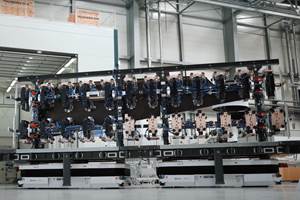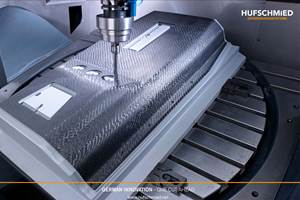Composite repair: Lessons learned, challenges and opportunities, Part II
In Part II, guest columnist Lou Dorworth says the wind and auto industries can learn much from the aerospace industry in this composites repair commentary.
Composite repair technology has progressed significantly over the past three decades, in large part because the aerospace industry has led the way. In Part I, we sketched the history of aerospace composites repair, tracing the developmental steps that have resulted in standard repair designs, materials and methods. These have built confidence among maintenance and repair organizations (MROs) that composite structures can be successfully and, increasingly, cost-effectively repaired.
The aerospace industry is introducing automated methods (e.g., robotic CNC machining) and standardizing repair technician training, aimed at better quality, reduced cost and faster turn-around, and is extending bonded repairs to increasingly larger areas of damage and flight-critical primary structures. This effort has been largely the result of industry collaboration through the Commercial Aircraft Composite Repair Committee (CACRC), administered by SAE International (Warrendale, PA, US). SAE’s Performance Review Board will be the certifying body for general and, soon, aerospace composite repair technicians.
The above holds much promise for those in other industries willing to benefit from the aerospace industry’s pioneering experience in composite repair. The wind turbine industry, in the repair of composite wind blades, and the now weight-conscious, and therefore, composites-aware, automotive industry both stand to gain. In each case, a similar spirit of collaboration, in terms of training and standardization, has the potential to improve quality and cost, and establish an effective supply chain.
Opportunities and challenges. For wind energy and automotive repairs, one challenge will be the current lack of standards. Wind turbine OEMs today bear little responsibility for developing repair methods and standard materials because they typically cover maintenance only for the first few years as part of the wind blade warranty. Thus, the onus of blade inspection and repair falls on wind farm developers/operators and their subcontractors. For example, the industry has struggled with the step vs. taper debate, and with how to replace multiaxial reinforcements in a way that matches constituent fiber axial orientation to ensure sufficient load transfer. Repairs, then, have commonly been oversized, not aerodynamic and possibly lacking in load efficiency. But as training has increased and as aerospace industry knowledge has been adapted, blade repair techniques have improved. Further, significant development in epoxy and polyurethane resins and cure methods for blade repair have provided better bond performance, making systems more tolerant of environmental conditions during repair and the large temperature range blades experience in service.
The automotive situation is more nascent and critical. Three years ago at SPE’s Automotive Composites Conference & Exhibition, the prevailing opinion was that carbon fiber would never figure significantly in new car design and “we’ll just replace parts vs. repair them.” McLaren, Lamborghini and other high-end manufacturers, however, already have vehicles on the road with significant amounts of carbon composite structures and have teams of “flying doctors” who perform aerospace-type repairs. However, they have not yet developed a system of zones or limits for allowable damage and composite repair designs. (Such a system has been proposed for wind blades.) These OEMs have done some analysis of front and rear impact, identifying where fractures might occur, which is used to assist the “repair doctors” with NDI. But not much has been done with side impact, and right now it is common to see composite monocoque “tubs” scrapped, even though they are repairable. Damage analysis, repair design and substantiation methods could easily be adapted from the aerospace industry.
In any case, the flying doctor scheme won’t be sustainable long term. BMW is already expanding its use of carbon structures into higher volume models, and as auto composites increase, so will the demand to repair rather than replace damaged composite parts. Current methods, in which large component pieces are sectioned and replaced to address smaller, locally damaged areas of a carbon fiber structure, don’t make sense with increasingly larger fleets.
Using existing localized repair methods already developed in the aerospace industry could bring composite structural repair capabilities to certified automotive collision repair centers. This would ultimately reduce the cost of new-generation vehicle repair to a level more closely aligned with the wishes of insurance companies and vehicle owners. Infrastructure for training and certification of auto collision repair centers is already well-established in many other areas through the international, nonprofit Inter-Industry Conference on Auto Collision Repair (I-CAR, Hoffman Estates, IL, US).
It would benefit the auto industry to begin collaboration now and to intelligently transfer and adapt technology and lessons learned, rather than re-inventing it, so that development of automotive composite repairs does not take 30-plus years, as it has in the aerospace industry.
Mr. Dorworth will discuss this topic in detail at CompositesWorld’s Carbon Fiber 2016 conference (Nov. 9-11, Scottsdale, AZ, US).
Related Content
From the CW Archives: Drilling is not for the faint of heart
This edition of From the CW Archives revisits CW’s first plant tour — a visit to the F-35 FAL in Fort Worth, Texas — and a story by Ginger Gardiner a few years later. Both offer lessons on how to perform stacked drilling through composite and metallic materials.
Read MoreGerman UniFix project develops mobile holding fixture to enhance production efficiency of large CFRP structures
Fraunhofer IFAM and Airbus Operations in Stade demonstrate reduced manual handling and non-productive time in flow-oriented manufacturing of vertical tail plane.
Read MoreSpecialized cutting tool equipment accommodates automotive requirements
CAMX 2023: Hufschmied’s machining systems, particularly the company’s 194/195 T-Rex cutting tools and carbide cutting blades, are being presented for use on plastics, composites and other materials.
Read MoreTop 10 Considerations When Buying a CNC Machine for Composites
For a CNC machine to continue to meet or exceed a company’s needs, it must be built and spec’d with these needs in mind.
Read MoreRead Next
CW’s 2024 Top Shops survey offers new approach to benchmarking
Respondents that complete the survey by April 30, 2024, have the chance to be recognized as an honoree.
Read MoreFrom the CW Archives: The tale of the thermoplastic cryotank
In 2006, guest columnist Bob Hartunian related the story of his efforts two decades prior, while at McDonnell Douglas, to develop a thermoplastic composite crytank for hydrogen storage. He learned a lot of lessons.
Read MoreComposites end markets: Energy (2024)
Composites are used widely in oil/gas, wind and other renewable energy applications. Despite market challenges, growth potential and innovation for composites continue.
Read More













.jpg;maxWidth=300;quality=90)

.jpeg;maxWidth=300;quality=70)






